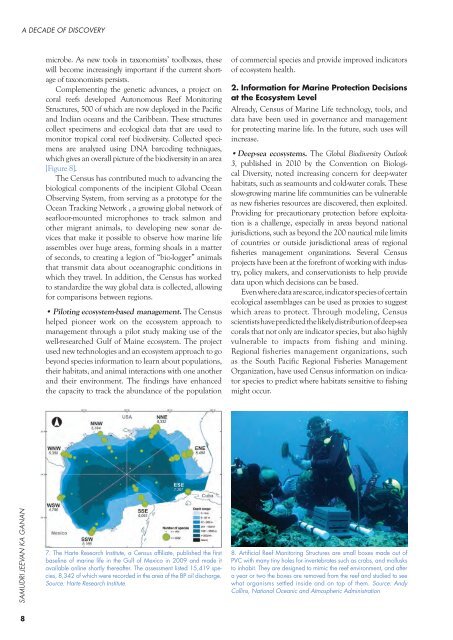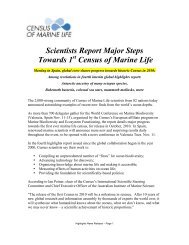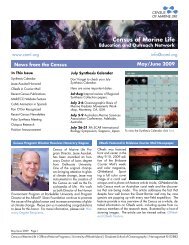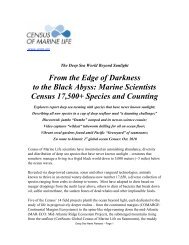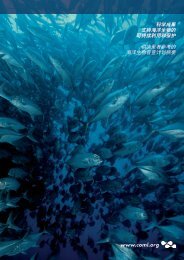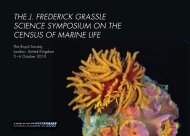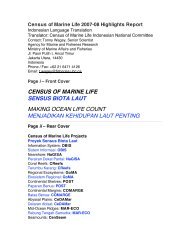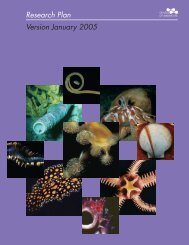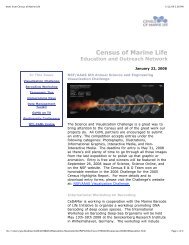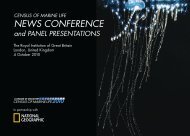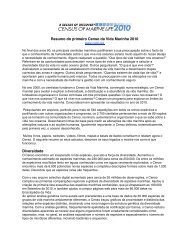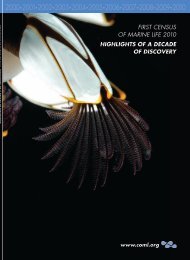A DECADE OF DISCOVERYmicrobe. As new tools in taxonomists’ toolboxes, thesewill become increasingly important if the current shortage<strong>of</strong> taxonomists persists.Complementing the genetic advances, a project oncoral reefs developed Autonomous Reef MonitoringStructures, 500 <strong>of</strong> which are now deployed in the Pacificand Indian oceans and the Caribbean. These structurescollect specimens and ecological data that are used tomonitor tropical coral reef biodiversity. Collected specimensare analyzed using DNA barcoding techniques,which gives an overall picture <strong>of</strong> the biodiversity in an area[Figure 8].The <strong>Census</strong> has contributed much to advancing thebiological components <strong>of</strong> the incipient Global OceanObserving System, from serving as a prototype for theOcean Tracking Network , a growing global network <strong>of</strong>seafloor-mounted microphones to track salmon andother migrant animals, to developing new sonar devicesthat make it possible to observe how marine lifeassembles over huge areas, forming shoals in a matter<strong>of</strong> seconds, to creating a legion <strong>of</strong> “bio-logger” animalsthat transmit data about oceanographic conditions inwhich they travel. In addition, the <strong>Census</strong> has workedto standardize the way global data is collected, allowingfor comparisons between regions.• Piloting ecosystem-based management. The <strong>Census</strong>helped pioneer work on the ecosystem approach tomanagement through a pilot study making use <strong>of</strong> thewell-researched Gulf <strong>of</strong> Maine ecosystem. The projectused new technologies and an ecosystem approach to gobeyond species information to learn about populations,their habitats, and animal interactions with one anotherand their environment. The findings have enhancedthe capacity to track the abundance <strong>of</strong> the population<strong>of</strong> commercial species and provide improved indicators<strong>of</strong> ecosystem health.2. Information for <strong>Marine</strong> Protection Decisionsat the Ecosystem LevelAlready, <strong>Census</strong> <strong>of</strong> <strong>Marine</strong> <strong>Life</strong> technology, tools, anddata have been used in governance and managementfor protecting marine life. In the future, such uses willincrease.•Deep-sea ecosystems. The Global Biodiversity Outlook3, published in 2010 by the Convention on BiologicalDiversity, noted increasing concern for deep-waterhabitats, such as seamounts and cold-water corals. Theseslow-growing marine life communities can be vulnerableas new fisheries resources are discovered, then exploited.Providing for precautionary protection before exploitationis a challenge, especially in areas beyond nationaljurisdictions, such as beyond the 200 nautical mile limits<strong>of</strong> countries or outside jurisdictional areas <strong>of</strong> regionalfisheries management organizations. Several <strong>Census</strong>projects have been at the forefront <strong>of</strong> working with industry,<strong>policy</strong> makers, and conservationists to help providedata upon which decisions can be based.Even where data are scarce, indicator species <strong>of</strong> certainecological assemblages can be used as proxies to suggestwhich areas to protect. Through modeling, <strong>Census</strong>scientists have predicted the likely distribution <strong>of</strong> deep-seacorals that not only are indicator species, but also highlyvulnerable to impacts from fishing and mining.Regional fisheries management organizations, suchas the South Pacific Regional Fisheries ManagementOrganization, have used <strong>Census</strong> information on indicatorspecies to predict where habitats sensitive to fishingmight occur.SAMUDRI JEEVAN KA GANAN7. The Harte Research Institute, a <strong>Census</strong> affiliate, published the firstbaseline <strong>of</strong> marine life in the Gulf <strong>of</strong> Mexico in 2009 and made itavailable online shortly thereafter. The assessment listed 15,419 species,8,342 <strong>of</strong> which were recorded in the area <strong>of</strong> the BP oil discharge.Source: Harte Research Institute8. Artificial Reef Monitoring Structures are small boxes made out <strong>of</strong>PVC with many tiny holes for invertebrates such as crabs, and mollusksto inhabit. They are designed to mimic the reef environment, and aftera year or two the boxes are removed from the reef and studied to seewhat organisms settled inside and on top <strong>of</strong> them. Source: AndyCollins, National Oceanic and Atmospheric Administration8
SUMMARY FOR DECISION MAKERSThe deep-sea projects <strong>of</strong> the <strong>Census</strong> that investigatedvents and seeps, seamounts, and abyssal plainsgave definition to previously hinted-at links betweenbiodiversity and the occurrence <strong>of</strong> valuable living andnon-living resources. The <strong>Census</strong> greatly expanded theknowledge <strong>of</strong> (1) cold water corals along margins andseamounts associated with commercial fish stocks, (2)luxuriant chemosynthetic communities <strong>of</strong> large worms,mussels and clams, as well as bacterial mats associatedwith cold seeps on continental margins that are richin methane and are linked to oil reservoirs and gashydrates, and (3) highly productive ecosystems, rich inlife due to chemosynthetic bacteria living in symbiosiswith large organisms (e.g., worms and molluscs), andfound on oceanic ridges associated with hot vents richin sulphides, methane, and minerals like copper, gold,silver, and zinc.Based in part on <strong>Census</strong> work on deep-sea coralassociations with seamounts, the North East AtlanticFisheries Commission in 2009 voted to close morethan 330,000 sq km to bottom fisheries on the Mid-Atlantic Ridge, an area larger than the United Kingdomand Ireland combined. At the Oslo-Paris Commission,several proposals for high-sea marine protected areaswere submitted and endorsed at the ministerial level,again using <strong>Census</strong> information from the mid-Atlantic.In late 2008, the Commission for the Conservation <strong>of</strong>Antarctic Living Resources protected two Vulnerable<strong>Marine</strong> Ecosystems from long-line fishing, based on imagesand samples <strong>of</strong> large red seaweed assemblages from<strong>Census</strong> Antarctic researchers.The <strong>Census</strong> chemosynthetic vents project helpedconduct an environmental impact assessment <strong>of</strong>possible biodiversity impacts <strong>of</strong> deepwater mineralextraction for deep-sea mining companies in PapuaNew Guinea and worked with the International SeabedAuthority to develop Codes for the EnvironmentalManagement <strong>of</strong> <strong>Marine</strong> Minerals. <strong>Census</strong> data fed intodesigning a Preservation Reference Area network<strong>of</strong> the International Seabed Authority to managepotential mining for polymetallic nodules in the Clarion-Clipperton Fracture Zone <strong>of</strong> the central Pacific Ocean.•Identification <strong>of</strong> ecologically or biologically significantareas and vulnerable marine ecosystems. <strong>Census</strong>information was pivotal in helping parties to theConvention on Biological Diversity (CBD) identifyareas <strong>of</strong> potential future value that should be protecteduntil they can be properly managed. The <strong>Census</strong>assisted the CBD in defining potential ecologically orbiologically significant areas (EBSAs) in areas beyondnational jurisdiction. In 2008, the CBD agreed onscientific criteria for EBSAs. These criteria were thentested by pilot illustrations for 15 different areas orspecies. Working with members <strong>of</strong> the Global OceanBiodiversity Initiative (GOBI) and other researchers,<strong>Census</strong> researchers demonstrated the importance <strong>of</strong>organized, publically accessible data portals, such asOBIS, that could deliver the results <strong>of</strong> over 800 existingquality-controlled data collections, including all datagathered by <strong>Census</strong> projects.This information was then used in a decision by theCBD at its 10th Conference <strong>of</strong> the Parties to effectivelyestablish a repository and a process for identifyingcandidate EBSAs, emphasizing the use <strong>of</strong> the <strong>Census</strong>data through OBIS and GOBI. Once candidate EBSAsare identified, the United Nations General Assemblyor other competent governing body could use them toimplement management measures helping to conservebiodiversity, including the establishment <strong>of</strong> marine protectedareas.Input from <strong>Census</strong> researchers was also important inthe United Nation’s Food and Agricultural Organizationdiscussions on management <strong>of</strong> deep-sea fisheries on thehigh seas, providing background information to nationaldelegates formulating the final set <strong>of</strong> international guidelinesfor these vulnerable marine ecosystems.• Tracking trans-boundary fisheries species. Many marineecosystems are connected by ocean currents andshared stocks, thus trans-boundary issues are critical todecision makers in conservation, industry, and government.The <strong>Census</strong> used advanced tagging technologieson iconic trans-boundary fished species. For Pacificsalmon, for example, individual fish were trackedfrom their home rivers in Canada along the BritishColumbia coast to Alaska. Atlantic bluefin tuna weretracked from the Gulf <strong>of</strong> Mexico to the Mediterraneanand back again. These data reveal previously unknowninformation about species habitat such as natalhoming <strong>of</strong> the tuna or ecosystem connectivity throughthe long-distance movement <strong>of</strong> animals. Taggingand tracking technology also documented that, in someparts <strong>of</strong> the ocean, species congregate, pointing to hotspotsand migration corridors.The Ocean Tracking Network, a <strong>Census</strong> legacyproject supported by the Government <strong>of</strong> Canada andcovering 14 ocean regions <strong>of</strong>f all seven continents, isnow applying advanced acoustic and tagging technologies.The project tags a wide range <strong>of</strong> marine speciesand records their location as they swim over “listeninglines,” lines <strong>of</strong> acoustic receivers situated on the oceanfloor. Through the network, thousands <strong>of</strong> commercialand endangered marine animals will be tagged toincrease understanding <strong>of</strong> what lives where and whenin the oceans. Knowing where fish actually travel makesit easier to designate new marine protected areas, setshipping routes, and site oil and gas exploration.CENSUS OF MARINE LIFE9


